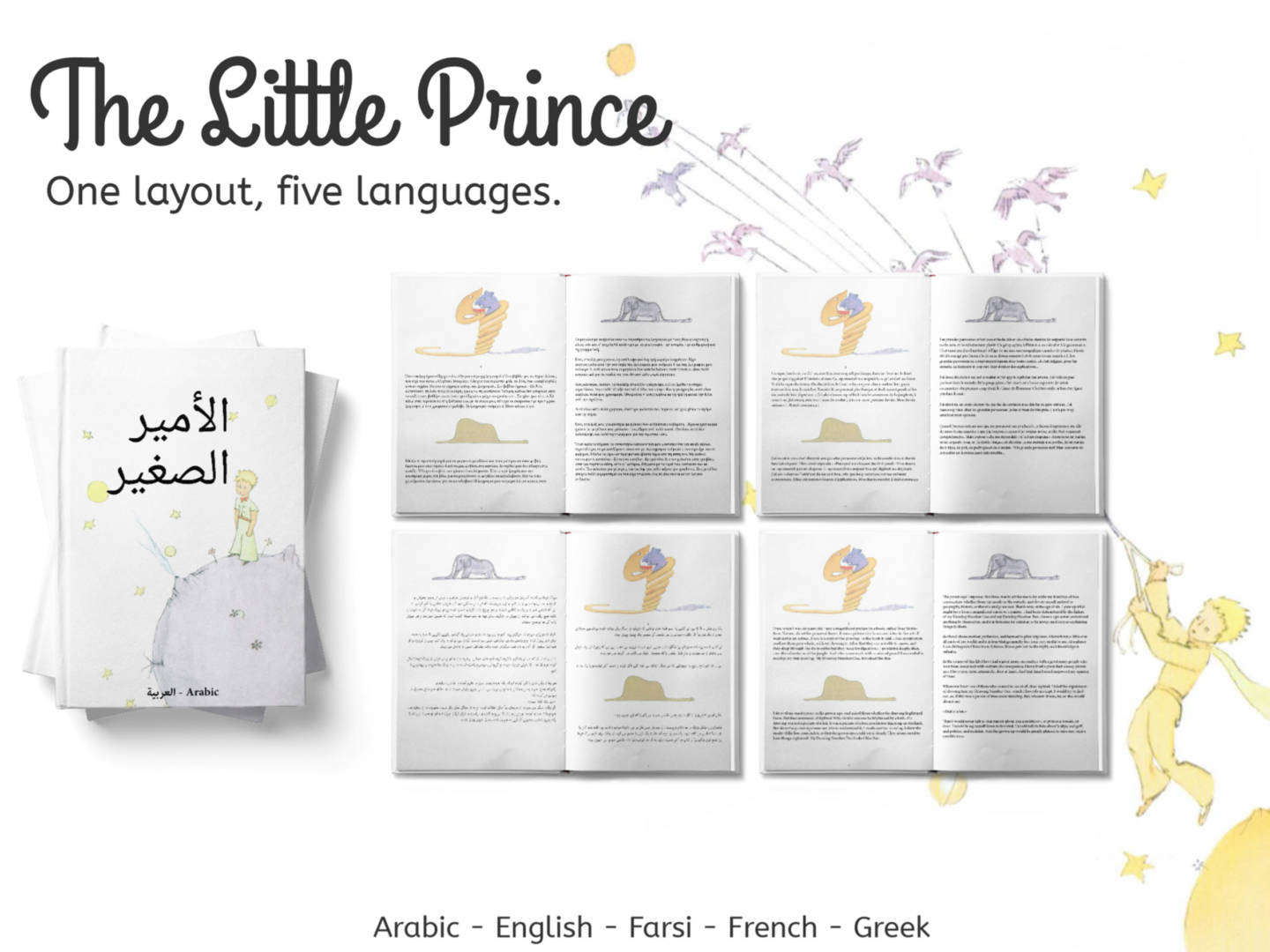The Little Prince
Description: A world-famous book that can improve educational activities by providing a single layout to translated versions.
Company: Self-initiated
Job title: Designer
Location: Lesvos island, Greece
Year: 01.01.2020
SDGs: Goal 4 and 10
Access to The Little Prince (pdf):
- Arabic – الأمير الصغير
- English* – The Little Prince
- Farsi – شازده کوچولو
- French* – Le Petit Prince
- Greek – Ο Mικρός Πρίγκιπας
- Download them all
– Last edit 05.01.2020.
What?
“One layout for The Little Prince.”
By gathering translated versions of the world famous story and using a standardized single layout, we improve education. People can read at the same time and help each other. It improves collaboration and pushes boundaries away.
One story, five languages and twenty students turning the page at the same time.
Why?
Educational activities are a recurrent topic when you’re coordinating a Child-Friendly Space on Lesvos.
Our values for education have always been to “learn through play” and “let the kids being part of the creation process”. However to bring reading as an activity can quickly become a challenge. Donation of qualitative books in Arabic, Farsi and French are not easy to get.
The idea came when I saw a Farsi student painting the Little Prince cover. A memory from my childhood popped-up:
The Little Prince is the third most translated book in the world with more than 250 languages.
As a designer, I try to find solutions that are usable by everyone and/or replicable. The Little Prince is now free of copyrights -except in France- so it can be shared to all the NGOs of Lesvos and potentially improve the global educational level on the island just by providing a relevant tool to the skilful teachers.
How?
A designer who tried to work with Arabic or Farsi documents knows the struggle of our Occidental tools to adapt. It’s a real challenge especially when you can’t understand any single word of these alphabets…
But after two years of experience doing documents in different alphabets, I developed a workflow to mitigate mistakes as much as possible.
You spotted a mistake? Send me a message.
Printing advices
1. Print yourself
This book has 68 pages total. You can print two different ways:
– in A5 format (booklet): using 17 sheets of A4 paper folded in two and printed recto-verso. It is easier to transport.
– in A4 format (classic): using 34 sheets of A4 paper printed recto-verso and bound together. The text would be larger and easier to read for some people, especially younger ones.
If you want to print it from home:
– Open the pdf, click on “Print”.
– Select the option “booklet” to arrange the pages automatically.
– On Booklet subset: select “Both sides” if your printer has this option. Or print one side, put the printed paper back on the tray, and print the other side.
– IMPORTANT: select right binding for the Arabic and Farsi versions and left binding for the other three versions.
– Fold the paper one by one and bind them together.
– You can trim (ruler & cutter) the outside edges of the book for a better finish.
2. Go to the print shop
For better looking, it is best advised to go to your print shop and ask for best practices advice. Print shops have different methods. A professional printer will give you different options for printing: the colour, the size, and the binding method. These options will differ in price significantly.
Not every binding method is good for a book of 68 pages. You can read more about it on this great document. It might be too little pages for a hard cover.
3. Do a workshop
Another idea is to print it at your office and run a binding workshop. This is an adult workshop, it needs patience and care but you can find tutorials on Youtube:
– Kettle stitch binding with signatures
– Binding with a sewing machine
– Book Binding Glue Version
If you printed it, send me a picture! 🙂
Next step for this project
- Create English learning versions: with English on the left page and another language on the right page. This could be useful outside school: for self-taught individuals and for parents to read with their children in both languages.
- Add more languages based on needs and resources.
À mes ami·e·s français·es,
Le Petit Prince est libre de droit dans la majeure partie des pays excepté la France. N’habitant pas en France, je peux donc utiliser la version francophone de Belgique pour créer ce travail et le partager. Cependant, et selon mes compétences limitées en droit:
- Si vous êtes en France, vous n’avez pas le droit de visionner ni de télecharger ce document.
- Vous avez le droit de télécharger, lire et partager la version francophone seulement si vous n’êtes pas en France.
- Le site www.cedricfettouche.com n’héberge aucun fichier. Il semble que “La loi française vous autorise à télécharger un fichier si vous en possédez l’original.” (source:warez) Ni www.cedricfettouche.com, ni personne ne pourront être tenus responsables d’une mauvaise utilisation de ce site.”
To my fellow friends living in the US,
I cannot be as specific with the American law than with the French law but I found this for you: “this title [The Little Prince] most likely remains copyrighted under United States law, where works copyrighted in 1924 or later can remain under copyright for up to 95 years after publication. […] Do NOT download or read this book online if you or your system are in the United States.”
